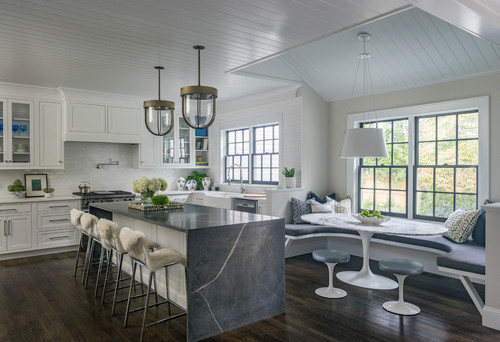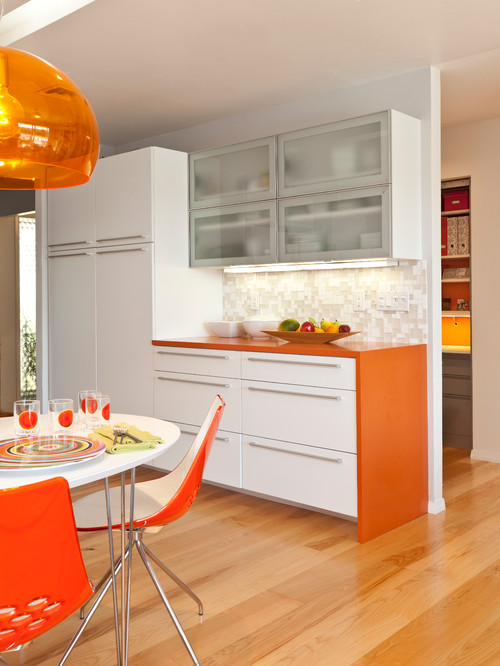See how this look can work with contemporary and transitional spaces, plus which outlet styles support this sleek look
By:Barbra Bright
When waterfall countertops first arrived on the design scene about six years ago, many designers thought they would be an ephemeral trend. In fact, they only seem to be gaining momentum.
Traditionally, a countertop is a horizontal surface that ends at the edge of the cabinets. With waterfall countertops, the material used on the horizontal surface continues vertically to the floor, essentially wrapping the side of the cabinet. The continuity of the material, particularly when it is stone, can create a dramatic focal point in the kitchen. Read on to see if this look might work for you, and what elements you’ll want to consider.
What’s so Great About Waterfalls?
With a waterfall edge, the veining in natural stone or quartz is visible on the horizontal plane, then spills over the edge in a vertical drop to the floor. This vertical view of the counter highlights and dramatizes the beauty of the stone’s veining, creating a focal point in the kitchen. Often, this focal point is also visible from other rooms, as shown in this photo.
Though stone remains a top choice for waterfall counters, recently materials like wood and concrete have also been gaining popularity.
Observe the Actual Edge
Pay attention to edge thickness. Waterfall countertops are available in various thicknesses, and the choice really depends on your personal preference. Some edges are only the thickness of the slab itself, as shown in this photo of the blue monochromatic kitchen with brass accents and light wood stools.
Other counters can be more than 3 inches thick, as with the stunning brown agate waterfall counter shown in this photo.
There really isn’t a hard and fast rule that determines what thickness will be right for you. Whether thin or thick, a range of edge sizes can work with a variety of design styles. Still can’t decide? This kitchen shows that you can have both thin and thick edges.
Where to Put a Waterfall
Contemporary kitchen. Waterfall countertops are most often found in contemporary kitchens due to their linear nature and clean lines, which are hallmarks of more contemporary style. The first three images in this story show contemporary kitchens with waterfall countertops.
How to Design a Warm Contemporary Kitchen
Transitional kitchen. This photo of a transitional-style kitchen shows that with a little imagination, the waterfall look can work outside of a contemporary kitchen. The island features a distressed-wood waterfall countertop juxtaposed with an elegant white marble countertop on the perimeter cabinetry. The wood waterfall edge adds character and interest to this transitional white kitchen, which blends traditional and contemporary styles.
Use a Waterfall as a Standout Feature
There is a plethora of white kitchens being created these days, so my goal as a designer is to make each one feel unique. One way is to use different countertop materials for the perimeter countertop and the island — whether classic marble or dramatic stone. Another is to mix wood with white. The following photos are of three white kitchens, each with different perimeter and island countertop materials, each evoking a different mood.
1. Muted. The soft coloring of the marble waterfall island gently blends with and complements the white cabinetry. It also coordinates with the backsplash stone, creating a harmonious look. The birdcage pendants, with their colorful occupants, add a touch of whimsy to this otherwise muted kitchen.
2. Contrasting. The black soapstone island with its singular white vein spilling over the edge brings contrast to this otherwise white kitchen. Surrounded by a sea of white, the black waterfall island draws the eye and is visually striking.
3. Drama. This island, with its dramatic waterfall countertop, adds a stunning focal point to this white and wood kitchen. The stone’s multi-hued coloring pulls together the different elements of this kitchen, seamlessly melding the two-toned cabinetry and four different tiles into one cohesive look.
Alternatively, you could choose a dramatic waterfall countertop and also use it on the perimeter counter, as in this photo. This quartz countertop with bold black and gray veining brings dramatic glamour to this otherwise white kitchen. The pattern is also echoed in the backsplash.
Waterfall countertops are most frequently used on islands, but not always. Here are some other options.
1. End of a cabinet run. A waterfall edge is an effective way to punctuate the end of a cabinet run. This orange quartz countertop coordinates with the pendant and kitchen chairs to add a pop of color to this white kitchen.
2. Peninsula. Here, the waterfall edge acts as an end panel on a peninsula. Not only does it protect the side of the cabinets from scuffs and scratches, the overhang above the bar stools creates a counter for eating.
For more great ideas, visit: Houzz.com















 Not intended as a solicitation if your property is already listed by another broker. LPT Realty, LLC is a Licensed Real Estate Brokerage.
Not intended as a solicitation if your property is already listed by another broker. LPT Realty, LLC is a Licensed Real Estate Brokerage.